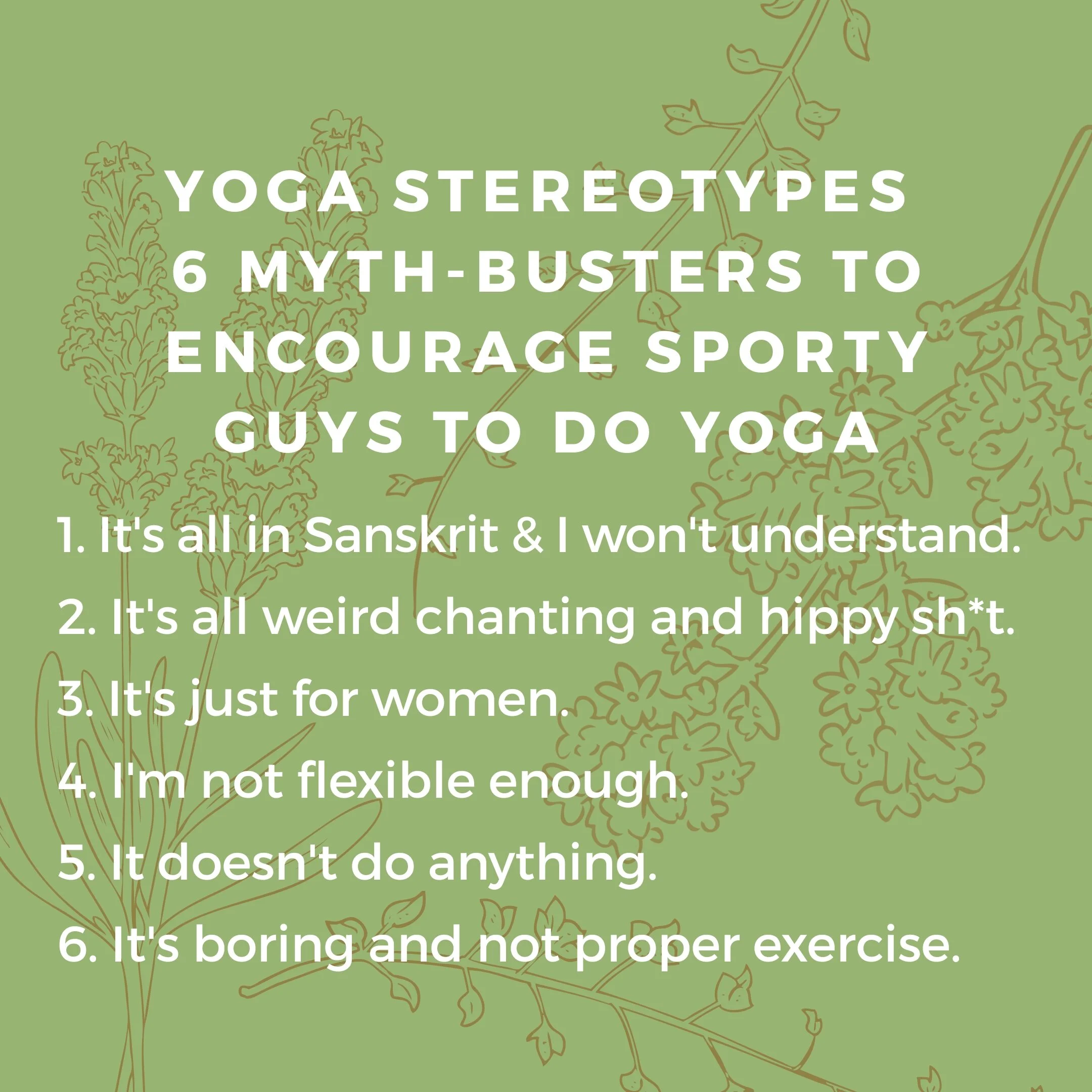Yoga stereotypes - 6 myth busters to encourage sporty guys to do yoga
I spend most of my fitness working life battling against the stereotypical images of yoga. Most of these put people off exploring yoga’s myriad benefits or make it look totally inaccessible unless you can tie yourself into knots. In most cases, the people most put off from adopting yoga into their fitness regime are men.
When I first launched Flexible Mindset, I posted a couple of questions out to my Facebook coterie, targeting my male chums in particular to try and unpick their images of the word ‘yoga’, the associations it has for them and what could be done differently to make them more keen to try it. The responses made fascinating reading, and the main themes of ‘opposition’ continue to come up when I talk to guys generally about yoga and the reasons why they have been put-off trying it or consider it ‘isn’t for them’.
Obviously, there will always be the odd exception, but in the main, the only sporty, active guys who I know utilise some yoga practice have either been personal trainers (and those from similar professions), or chaps who have had the benefits of yoga instilled in them by their female partners and have been persuaded to try it.
In my continued quest to challenge the preconceptions most men have in relation to yoga (or ‘stretching’ as one male friend insists on calling it!), here are the Top 6 myths I most often come across when discussing yoga with men and my attempt to dispel them:
1. It's all in Sanskrit and I won’t understand the language.
One of the biggest hurdles with any perceived inner sanctum, specialism or club is that they have their own language and code, which if left unexplained, makes an outsider feel stupid and/or excluded. People who genuinely love what they do and want other people to join in and benefit from their positive experiences will break down the specialist language to terminology, which makes sense to everyone and is wholly accessible. For instance, if a golfer says: ‘Join me for the back nine’ to someone new to the game, if they are genuinely wanting to make the feel part of the club, they should say: ‘Join me for the latter half of the course’.
It’s the same with yoga. I am not going to go and work with a bunch of footballers and cry out: ‘Right everyone, inhale into Bhujangasana, and then exhale into Adho Mukha Svanasana'. I am going to say the English name (Cobra to Downward Dog in case you were wondering!) and then explain exactly what they all need to do with their bodies to achieve the pose, where they should be feeling the stretch, what it’s doing to their bodies, key things to remember, modifications to make etc.; and in addtiona, wander round the room ensuring they are all in the right place and comfortable. Seek out a yoga instructor that offers the latter, explaining each pose accurately and in normal language, and who knows their anatomy, and you will feel ‘part of the club’ instantly!
2. It’s all weird chanting and hippy sh*t
Admittedly yoga has its roots in the ancient philosophy, teachings and religious practices of India, and only gained popularity throughout the twentieth century from the teachings of BKS Iyengar, who brought it to a more Western audience in the 1960s and 70s, when it was associated with the hippy movement and sexual liberation etc.
However, as the multiple long-term benefits of yoga are now fully recognised, it has evolved into a huge worldwide movement with so many different types and versions to choose from. There is something for everyone, and not every class involves gong baths, chanting and chakras and more and more yoga is being used as a complementary activity in professional sports training, which is my area. Like my fellow practitioners, I strip yoga down to its essence and utilise the best of its posture and breathing techniques to assist in a range of performance improving and injury prevention techniques, amongst other benefits. Do your research, attend a few drop-in classes, or find someone like me who does one-to-one sessions, and you’ll soon find a style that works for you.
3. It’s just for middle-aged ladies, yummy mummies and girls in pink crop tops contorting themselves on Instagram
There is a heck of a lot of this about. Why is yoga seen as the bastion of female exercise? Interestingly yoga was practiced mainly by men until it was westernised in the 1970s… Not helping with this misnomer is social media, plastered with millions of (in some cases, frankly disturbing) pictures of super skinny women in next-to-nothing contorting themselves into impossible positions. Think of this next time you see these pictures: Many of these women are hyper-mobile, i.e. their joints bend and stretch farther than they should. If they continue to do these crazy positions it will result in them having joint replacement surgery at a relatively young age. The rest isn’t yoga, it’s more like soft porn (yuk).
Outside of social media, I get it! There is nothing more intimidating than walking into a room and sticking out like a sore thumb. Whether it’s walking into a room full of the opposite gender, an obvious age gap or a different culture/ethnic group, only the bravest soles do this more than once. Only in power and hot yoga do you get a good gender balance in my experience and do you notice the language? ‘Hot’ & ‘Power’ are words much more associated with being masculine. If you want to try yoga, sign up for classes that have these kinds of words in the description, if you want to feel less conspicuous. Or create a ‘safety in numbers’ and gather a couple of mates together and go as a small group. Alternatively, if you belong to a sports club, are part of a team or more of a solo trainer, you can hire someone like me to work with you in a private session creating a safe and comfortable space.
4. You must be flexible to do yoga and I can’t even touch my toes
Erm…well the whole point of investing in yoga or flexibility training is to become more flexible! If you were already flexible, you would either have been doing yoga for years, be a professional gymnast, or have hypermobililty, which comes with a whole heap of issues. A good instructor should be able to assess your range of motion, anatomical make-up, postural issues etc pretty quickly and create a programme or run a session, which allows you to focus on areas that you need to work on the most. They should also encourage you to focus on your own limitations and how to work through them rather than judging yourself on what the person in front of you can do. To use a quote that a fellow yoga chum posted the other day: (https://cowfaceyoga.fit/) ‘Saying that you’re not flexible enough to do yoga, is like saying you’re too dirty to have a bath!’
5. Yoga’s a waste of time as you don’t really do anything apart from ponce around on a mat
Oh, my friends, you are so wrong! Where do I start with its multiple benefits: Increased flexibility/range of motion; injury prevention/rehabilitation; increased proportional strength; better core strength and lumber spine protection; better understanding of how to breathe properly, promoting greater oxygen/CO2 balance in the body, greater lung capacity, better efficiency and performance and faster recovery times; less anxiety & stress, aiding faster recovery, better endurance and tolerance, better sleep, improved posture, which aids well-being and improves your appearance and how you project yourself to others; improved joint mobility; elongated and strengthened muscles, which also promotes stronger bones…and these are just for starters! I rest my case on this one…
6. It’s boring and slow and I’m more interested in doing real exercise that works up a sweat etc.
This is always a preconception from people who have never done a session of yoga, and especially from men whose perception of yoga is that its just for girls. I am not sure what they think women’s exercise is: that we shuffle about in crinolines or something, not bearing our ankles and perhaps play a bit of light croquet or similar? I would question whether they have watched a sportswoman in action over the last 40-odd years. Suffice to say, after a session of yoga – usually when my male friends have been dragged along by their partners, or my female chums have taken a husband in tow – the feedback from these yoga virgins is along the lines of ‘I’m exhausted’, ‘It’s so much harder than it looks’ or ‘I hadn’t realised how fit yoga people were’. Indeed…
Okay, it does come down to the type of yoga in which you are taking part, and admittedly you aren’t going to whip through the calorie counter during a session of restorative or yin yoga, but it’s all in the name, fellas! If you go to anything like power, hot, ashtanga or a vinyasa flow class, you’ll come out with a full body workout covering cardio, strength, flexibility, breath, balance and coordination. Just to move your leg from downward dog, to land between your hands at the front of the mat, requires strong abs/core, coordination, and balance, and that’s just one transition. With a one-hour class, you’re often powering through 50-60 individual poses and the transitions between them!
In conclusion, I figure if the New Zealand All Blacks incorporate yoga into their rugby training regime, and they are about as big and manly a sporting bunch as you can find, it should be seen in a better light with other sporty males!
I hope I have helped change your thinking in relation to yoga and flexibility training, and encouraged you to give it a try, or at the very least given other instructors some ammunition to help keep busting the myths around yoga stereotypes that we face on a daily basis?

